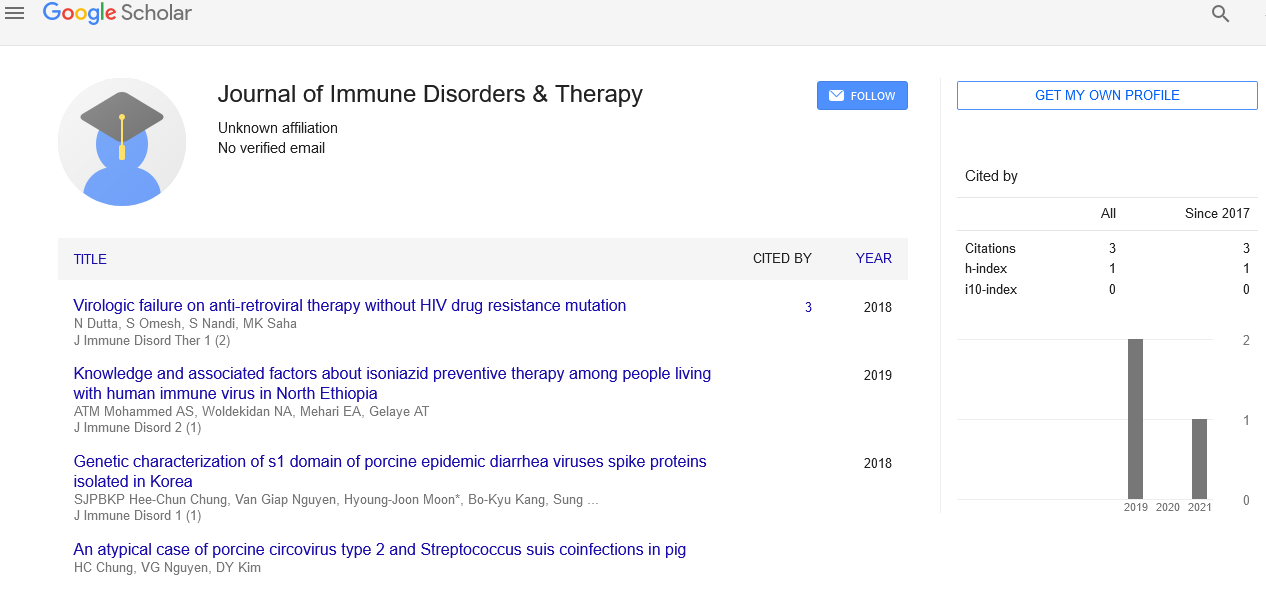Editorial on Immunology
Received: 10-Jun-2021 Accepted Date: Jun 14, 2021; Published: 01-Jul-2021, DOI: 10.37532/puljidt.2021.4(3).e001
This open-access article is distributed under the terms of the Creative Commons Attribution Non-Commercial License (CC BY-NC) (http://creativecommons.org/licenses/by-nc/4.0/), which permits reuse, distribution and reproduction of the article, provided that the original work is properly cited and the reuse is restricted to noncommercial purposes. For commercial reuse, contact reprints@pulsus.com
Abstract
In basic terms, the immune system has two lines of defense: innate immunityand adaptive immunity. Innate immunity is the first immunological, nonspecific(antigen-independent) mechanism for fighting against an intrudingpathogen. It is a rapid immune response, occurring within minutes or hours
after aggression, that has no immunologic memory. Adaptive immunity, on the other hand, is antigen-dependent and antigen-specific; it has the capacity
for memory, which enables the host to mount a more rapid and efficient immune response upon subsequent exposure to the antigen. There is a
great deal of synergy between the adaptive immune system and its innate counterpart, and defects in either system can provoke illness or disease, such
as autoimmune diseases, immunodeficiency disorders and hypersensitivity reactions. This article provides a practical overview of innate and adaptive
immunity, and describes how these host defense mechanisms are involved in both health and illness.
Haberler
Haberler
Haberler
Haberler
Haberler
Haberler
Haberler
Haberler
Haberler
Haberler
Haberler
Haberler
Haberler
Haberler
Haberler
Haberler
Haberler
Haberler
Haberler
Haberler
Haberler
Haberler
Haberler
Haberler
Haberler
Haberler
Haberler
Haberler
Haberler
Haberler
Haberler
Haberler
Haberler
Haberler
Haberler
Haberler
Haberler
Haberler
Haberler
Haberler
Haberler
Haberler
Haberler
Haberler
Haberler
Haberler
Haberler
Haberler
Haberler
Haberler
Editorial
Over the past decade, there have been numerous advances in our current understanding of the immune system and how it functions to protect the body from infection. Given the complex nature of this subject, it is beyond the scope of this article to provide an in-depth review of all aspects of immunology. Rather, the purpose of this article is to provide medical students, medical residents, primary-care practitioners and other healthcare professionals with a basic introduction to the main components and function of the immune system and its role in both health and disease. This article will also serve as a backgrounder to the immunopathological disorders discussed in the remainder of this supplement. The topics covered in this introductory article include: innate and acquired immunity, passive and active immunization and immunopathologies, such as hypersensitivity reactions, autoimmunity and immunodeficiency.
The immune system refers to a collection of cells and proteins that function to protect the skin, respiratory passages, intestinal tract and other areas from foreign antigens, such as microbes (organisms such as bacteria, fungi, and parasites), viruses, cancer cells, and toxins. The immune system can be simplistically viewed as having two “lines of defense”: innate immunity and adaptive immunity. Innate immunity represents the first line of defense to an intruding pathogen. It is an antigen-independent (non-specific) defense mechanism that is used by the host immediately or within hours of encountering an antigen. The innate immune response has no immunologic memory and, therefore, it is unable to recognize or “memorize” the same pathogen should the body be exposed to it in the future. Adaptive immunity, on the other hand, is antigen-dependent and antigen-specific and, therefore, involves a lag time between exposure to the antigen and maximal response. The hallmark of adaptive immunity is the capacity for memory which enables the host to mount a more rapid and efficient immune response upon subsequent exposure to the antigen. Innate and adaptive immunity are not mutually exclusive mechanisms of host defense, but rather are complementary, with defects in either system resulting in host vulnerability.
Innate immunity
The primary function of innate immunity is the recruitment of immune cells to sites of infection and inflammation through the production of cytokines (small proteins involved in cell-cell communication). Cytokine production leads to the release of antibodies and other proteins and glycoproteins which activate the complement system, a biochemical cascade that functions to identify and opsonize (coat) foreign antigens, rendering them susceptible to phagocytosis (process by which cells engulf microbes and remove cell debris). The innate immune response also promotes clearance of dead cells or antibody complexes and removes foreign substances present in organs, tissues, blood and lymph. It can also activate the adaptive immune response through a process known as antigen presentation.
Adaptive immunity
Adaptive immunity develops when innate immunity is ineffective in eliminating infectious agents and the infection is established. The primary functions of the adaptive immune response are the recognition of specific “non-self” antigens in the presence of “self” antigens; the generation of pathogen-specific immunologic effector pathways that eliminate specific pathogens or pathogen-infected cells; and the development of an immunologic memory that can quickly eliminate a specific pathogen should subsequent infections occur. The cells of the adaptive immune system include: T cells, which are activated through the action of antigen presenting cells (APCs), and B cells.
Autoimmunity
Autoimmunity involves the loss of normal immune homeostasis such that the organism produces an abnormal response to its own tissue. The hallmark of autoimmunity is the presence of self-reactive T cells, auto-antibodies, and inflammation. Prominent examples of autoimmune diseases include: Celiac disease, type 1 diabetes mellitus, Addison’s disease and Graves’ disease .
Immunodeficiency
Immunodeficiency refers to a state in which the immune system’s ability to fight infectious disease is compromised or entirely absent. Immunodeficiency disorders may result from a primary congenital defect (primary immunodeficiency) or may be acquired from a secondary cause (secondary immunodeficiency), such as viral or bacterial infections, malnutrition or treatment with drugs that induce immunosuppression. Certain diseases can also directly or indirectly impair the immune system such as leukemia and multiple myeloma. Immunodeficiency is also the hallmark of acquired immunodeficiency syndrome (AIDS), caused by the human immunodeficiency virus (HIV). HIV directly infects Th cells and also impairs other immune system responses indirectly.





